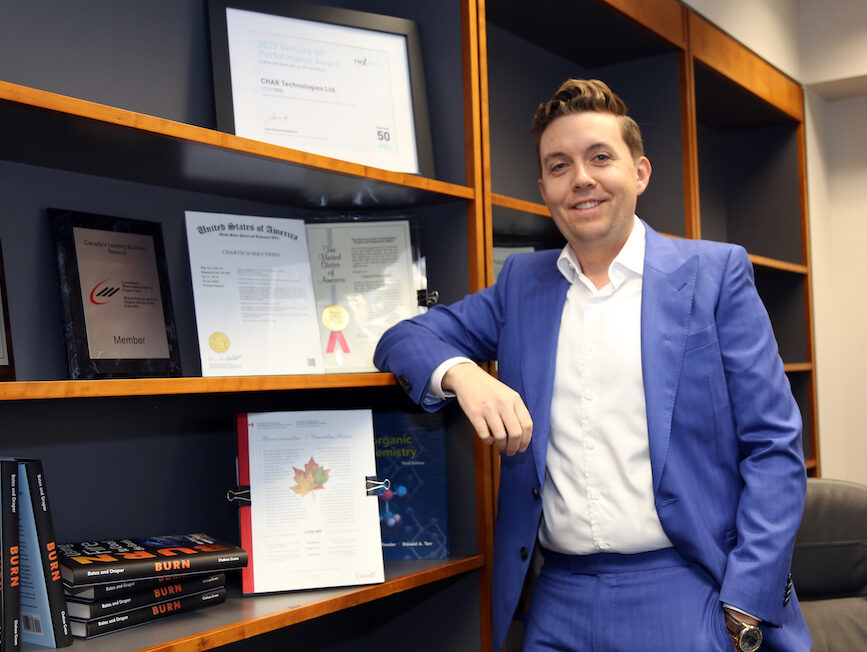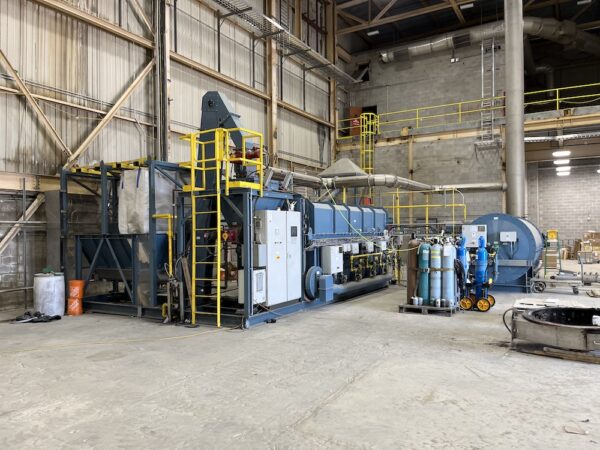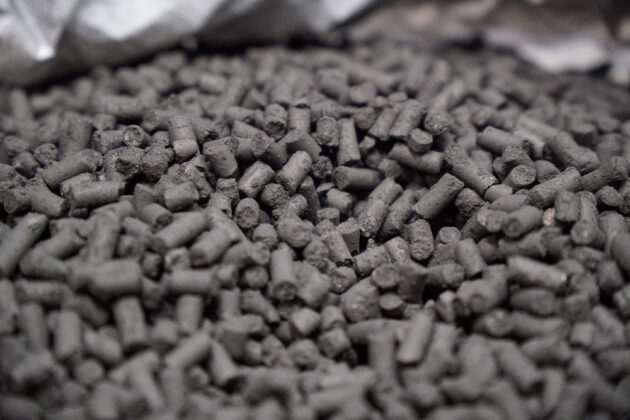
Heating up: Q&A with CHAR Technologies CEO Andrew White
September 28, 2023
By
Maria Church
 Andrew White, CHAR Technologies CEO. Photo: CHAR.
Andrew White, CHAR Technologies CEO. Photo: CHAR. Ontario’s CHAR Technologies has been making headlines this year with a flood of new projects and investments in the Canadian cleantech market.
The company is pioneering high-temperature pyrolysis to turn wood waste into renewable natural gas (RNG) and biocarbon in the form of biochar and biocoal. In July, CHAR announced a $6.6-million investment and annual biocarbon purchase agreement with global steel and mining company ArcelorMittal.
Canadian Biomass caught up with Andrew White, CHAR co-founder and CEO, for a behind the scenes look at their growing list of projects and agreements, and to hear White’s thoughts on the biocarbon market.
CB: Canadian Biomass first profiled CHAR in 2019 and much has happened for the company since then. What has that rapid progress looked like on your end?
It’s been an evolution, certainly. Now is when a lot of the hard work over the last four years is finally coming to fruition. Besides surviving the pandemic – which was interesting for everybody – we now have this condensed process where we’ve been able to start communicating with the market with what we’re doing and how we’re doing it.
In the background, we had our project planned for Thorold, and we had some initial progress on our other projects like Lake Nipigon, Kirkland Lake and Saint-Félicien. And we’ve been able to announce our funding package from the province and federal government for Thorold. A lot of that development work, funding work, strategic partnerships, have all come together here, relatively speaking, in a very short amount of time. But we’ve been working with a lot of these partners for years.

CHAR’s proprietary pyrolysis system that transforms organic waste into biocarbon. Photo: CHAR.
CB: How has the company evolved over the last few years?
A big move was our London facility to Thorold at the end of last year. We were producing carbon the second week of November ’22 in London, and the second week of January ’23 we were making it in Thorold. And we lost a week for Christmas. It was a great testament to the benefits of our modular technology. When we look at our future projects, that’s how we want to approach them – to be able to deploy fairly quickly by following this modularity approach.
Our plant when it was in London could input 500 kilograms per hour of material. The scaled-up version under construction in Thorold can input 3.5 tonnes per hour.
In 2019 we had started the transition to really recognize that the value for CHAR, the value for our shareholders and stakeholders, is in our involvement in owning the infrastructure. A build-own-operate model that is focused on RNG and biocarbon production. We’re still doing both, and we’re being selective with partners to build projects for them. Really getting into the RNG component of it, we’re now going to be deploying it in Thorold in the coming summer ’24.
We just announced the ArcelorMittal investment. To look behind the curtain a bit, we’ve been working with ArcelorMittal Dofasco in Hamilton for some years now, and there was a huge amount of due diligence involved. We went deep on the technology, deep on the business case with a third-party consultant, just to validate that, yes, the technology works, and the business case works, and this makes a lot of sense.
ArcelorMittal Dofasco then agreed to buy our production from our Thorold facility. We’re excited that not only did ArcelorMittal invest, ArcelorMittal Dofasco signed up to be our guaranteed customer. I think that’s excellent validation for all the work that’s gone on in the background.
CB: At what stage are CHAR’s projects announced across Canada?
[Lake Nipigon, Ont.:] We went up and we met with Lake Nipigon Forest Management Inc. group, which is a consortium of four First Nations groups who control the harvesting of about one million hectares of productive forest around the Lake Nipigon shore. We have the MOU in place as to what a JV [joint venture] structure would look like and now were working through the definitive agreement. We looked at a couple site options. And we want to get moving on the engineering design work and permitting work that will allow us to get started on some of the civil work by next construction season.
[Kirkland Lake, Ont.:] We’re moving along nicely. We’ve been working with the town on getting some of the infrastructure connections sorted out for the site we’ve identified and optioned. We’re looking to add to feedstock partners to work with and to bring into the project. We’re progressing that one fairly nicely. Key is getting the infrastructure sorted out.
[Saint-Félicien, Que.:] We’re part of a larger overall project where the city is progressing on a hot-water loop from a co-gen facility. The CVB (centre de valorisation de la biomasse), which includes the MRC Domain-du-Roy (regional government), are going to install a grinder and a dryer using the waste heat from the city’s hot-water loop, and we’re the off-taker of that dried and ground biomass. We’ve now engaged with a Quebec permitting consultancy so our permitting group at CHAR, Altech, is engaging with them to make sure everything is meeting the requirements.
[Terrace, B.C.:] We had identified sites and partners and the like, but the project development was put on a hold while we were waiting for funding approval from the Clean Fuels Fund. We’re ecstatic that it was approved. We think it will make a big difference to have other groups look at feasibility studies, not just us, in the Clean Fuels program. Now we’re able to re-engage in that project, finding the sites that are available, reengage on discussing partnership opportunities, and doing some preliminary engineering work and permitting work. It’s certainly earlier stage than the other three.

CHAR’s pelletized biocarbon that will be used by ArcelorMittal in replacement of coal. Photo: CHAR.
CB: How has the biochar/biocarbon market developed since 2019?
In our view, what we call biocarbon is the generic ‘anything that’s carbon that comes out of a thermochemical process’ – but not everyone agrees with this nomenclature. That’s one of the issues, what do we call everything? But we call it a biocarbon and the subsets for us are biochar and biocoal. For us, biocoal is high-quality, metallurgical coal replacement material.
On the biochar side, certainly the voluntary carbon credits through the Verras, the Puro.earths, have changed the opportunities on how to add value to biochar. To get the required value by the truckload and to get people – especially in the agricultural community – to buy it, is challenging. That said, deriving a second revenue stream through carbon credits is great, and really changes the overall economics of biochar. Because of how traceable those carbon credits are, they will continue to hold their value.
On the biocoal side, there is clearly an increasing need for decarbonizing heavy industry. And the steel makers, the smelters, they want to make this transition as well. The acceptance of biocoal has now really accelerated. Generally, there is an understanding that it can be even higher quality than metallurgical coal. End-users need to work with suppliers to really understand what biocoal’s qualities are so that it can be used as a drop-in coal replacement. We’re really seeing that acceptance.
CB: What’s your take on Canada’s policy environment for biomass cleantech companies?
For us specifically, because we are also in the RNG space, what we have seen right from the provincial levels is a view that RNG can come from anything as long as it’s renewable and creates methane. We’re not limited to an anaerobic digestor processing dairy manure to make valuable RNG. Biomass can be in there.
On the biocoal side, it’s interesting, because we’re more keen on the chemistry aspect of replacing metallurgical coal, versus replacing thermal coal. So, it’s not just a fuel, it’s a chemical addition, or reductant, which means we have to look at the GHG emissions in a slightly different method. I’m encouraged that the direction of a lot of policy is looking at carbon intensity [CI] versus technology type. Does the fuel emit a certain amount of CO2 or did it have a negative effect? If you’re more negative in CI score, then you should get a higher value for that material, similar to the Low Carbon Fuels Standard, but applied more broadly.
I think there is a good amount of government support. I do want to see where the production tax credits and investment tax credits in Canada wind up. That was a big element of the Inflation Reduction Act in the U.S. and it could play a big role here, especially getting over the commercialization hurdle. They can help de-risk a project to find funding sources. I’m optimistic – and I think I have to be! – about where we’ll wind up there.
This article is part of Biofuels Week 2023. To read more articles on biofuels, click here.
Print this page